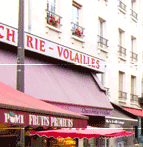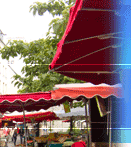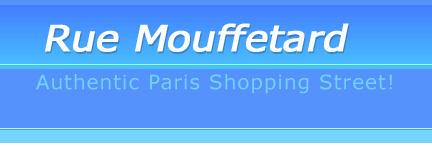Understanding Rue Mouffetard's Place in the Latin Quarter
While Rue Mouffetard is a destination in its own right, its location in the eastern Latin Quarter makes it an ideal starting point or component of a more extensive exploration of this fascinating area. The street's authentic market character complements the academic, historic, and cultural attractions that surround it, creating opportunities for diverse and rewarding visits.
Latin Quarter Quick Facts
- Location: Left Bank, primarily in the 5th Arrondissement
- Name Origin: From the Latin language spoken by students at the Sorbonne during the Middle Ages
- Character: Academic, historic, bohemian, with a mix of students and tourists
- Key Features: Universities, historic monuments, bookshops, cafes, narrow medieval streets
- Rue Mouffetard's Position: Eastern edge of the Latin Quarter, connecting to the more residential areas beyond
The Latin Quarter: A Brief Introduction
The Latin Quarter (Quartier Latin) is one of Paris' most historic and vibrant neighborhoods, covering much of the 5th Arrondissement and parts of the 6th. The area derives its name from the Latin language that was spoken by students at the Sorbonne University during the Middle Ages, when Latin was the language of academia.
For centuries, the Latin Quarter has been the intellectual heart of Paris, home to prestigious universities, historic libraries, and a tradition of philosophical and political discourse. This academic heritage created a unique atmosphere that continues today, with bookshops, cafes, and a youthful energy from the student population.
While the western portion of the Latin Quarter (near Boulevard Saint-Michel) has become more commercialized and tourist-oriented, the eastern section around Rue Mouffetard retains more of its authentic character and local atmosphere, offering visitors a glimpse of a more traditional Paris.
Historical Significance
The Latin Quarter's history stretches back to Roman times when it was part of Lutetia, the Roman settlement that would become Paris. The area has witnessed key moments in French history:
- The founding of the Sorbonne in 1253, establishing the area's academic character
- The development of printing shops and intellectual centers during the Renaissance
- Student revolts and revolutionary activities across centuries, including the significant events of May 1968
- The gathering of existentialist philosophers and writers in the mid-20th century
Cultural Character
Today's Latin Quarter blends several distinct atmospheres:
- Academic: With multiple universities and research institutions
- Historic: Featuring Roman ruins, medieval churches, and Renaissance architecture
- Bohemian: Home to artists, writers, and intellectuals for centuries
- Commercial: Particularly along Boulevard Saint-Michel and near major tourist sites
- Residential: With authentic neighborhood life, especially in the eastern sections
Rue Mouffetard represents the more authentic, residential aspect of the Latin Quarter, where daily Parisian life continues alongside tourism, creating a balanced and genuine experience for visitors.
Key Latin Quarter Attractions Near Rue Mouffetard
Rue Mouffetard is ideally situated for exploring other significant Latin Quarter attractions, making it easy to combine a market visit with cultural and historical sites. These nearby destinations can be incorporated into half-day or full-day itineraries centered around Rue Mouffetard.
Panthéon
Neoclassical monument housing the remains of distinguished French citizens including Voltaire, Rousseau, Victor Hugo, Marie Curie, and Alexandre Dumas. The building offers impressive architecture and panoramic views of Paris from its dome.
Opening Hours: Daily 10:00 AM-6:30 PM (April-September), 10:00 AM-6:00 PM (October-March)
Arènes de Lutèce
Hidden Roman amphitheater dating from the 1st century CE, one of the most important ancient Roman remains in Paris. Once seating 15,000 spectators, it's now a peaceful public park where locals play pétanque and children play.
Opening Hours: Daily 8:00 AM-5:30 PM (winter) or 10:00 PM (summer), free entry
Jardin des Plantes
Paris' main botanical garden, founded in 1626, featuring thousands of plant species, a small zoo, and several natural history museums. The garden offers beautiful seasonal displays and a tranquil escape from urban bustle.
Opening Hours: Daily 7:30 AM-8:00 PM (summer) or 5:30 PM (winter), free entry to gardens
Grande Mosquée de Paris
Beautiful mosque with Moorish architecture, gardens, and a renowned tea room serving mint tea and North African pastries. The mosque offers guided tours that provide insight into Islamic architecture and traditions.
Opening Hours: Saturday-Thursday 9:00 AM-12:00 PM and 2:00 PM-6:00 PM, closed Fridays
Sorbonne University
Historic university founded in 1253, with impressive architecture and a central role in French intellectual history. While the interior is generally closed to visitors, the courtyard and chapel can sometimes be visited during special events.
Visiting: Exterior viewable anytime; interior visits limited to special open days
Musée de Cluny
Museum of medieval art housed in a Gothic mansion built atop Roman baths, home to the famous "Lady and the Unicorn" tapestries. The museum offers a fascinating glimpse into medieval life and art in an atmospheric setting.
Opening Hours: Wednesday-Monday 9:30 AM-6:15 PM, closed Tuesdays
Luxembourg Gardens
One of Paris' most beloved parks, featuring formal gardens, fountains, statuary, and the Luxembourg Palace (now housing the French Senate). The garden offers a perfect place to relax after exploring Rue Mouffetard.
Opening Hours: Daily from 7:30 AM to between 4:30 PM and 9:30 PM depending on season
Saint-Étienne-du-Mont
Beautiful church combining Gothic and Renaissance elements, featuring a unique rood screen and the shrine of St. Geneviève, patroness of Paris. The church appears in the film "Midnight in Paris" and houses the tombs of Blaise Pascal and Jean Racine.
Opening Hours: Monday-Saturday 10:00 AM-7:45 PM, Sunday 8:30 AM-8:45 PM
Visitor Tip
Many of these attractions can be visited for free or at reduced cost with the Paris Museum Pass. The Panthéon, Musée de Cluny, and Natural History Museums at Jardin des Plantes are all included in the pass. Additionally, several sites offer free entry on the first Sunday of each month.
The Latin Quarter's Literary Heritage
The Latin Quarter, including Rue Mouffetard, has a rich literary history that adds another dimension to a visitor's experience. Many famous writers have lived in and written about this neighborhood, creating a literary landscape that can be explored alongside the physical one.
Hemingway's Rue Mouffetard
Ernest Hemingway lived at 74 Rue Mouffetard in the early 1920s and frequently mentioned the street in his memoir "A Movable Feast." His descriptions of shopping at the market and drinking in local cafes provide a fascinating historical perspective that still resonates today.
"This is how Paris was in the early days when we were very poor and very happy... The rue Mouffetard was crowded with wagons of vegetables for the market and the cobblestones were slippery with the refuse from the wagons."
Other Literary Connections
Beyond Hemingway, the Latin Quarter has been home to numerous writers and intellectuals whose presence has shaped its character:
- James Joyce frequented the cafes and bookshops of the Latin Quarter while working on "Ulysses"
- George Orwell described his experiences working as a dishwasher in the area in "Down and Out in Paris and London"
- Simone de Beauvoir and Jean-Paul Sartre held court at Café de Flore and Les Deux Magots, developing existentialist philosophy
- Verlaine and Rimbaud, the famous French poets, lived and wrote in the neighborhood
- Victor Hugo set parts of "Les Misérables" in the Latin Quarter's winding streets
These literary connections have left an indelible mark on the neighborhood's character and continue to attract literary pilgrims from around the world.
Literary Walking Tour
Literary enthusiasts can create their own walking tour connecting Rue Mouffetard with other significant sites in the Latin Quarter. Start at 74 Rue Mouffetard (Hemingway's apartment), continue to Place de la Contrescarpe (featured in "A Movable Feast"), then visit Shakespeare and Company bookstore near Notre-Dame, and finish at the historic cafes of Boulevard Saint-Germain where existentialist philosophers gathered in the mid-20th century.
Suggested Walking Routes
Rue Mouffetard serves as an excellent starting point or component of various walking routes through the Latin Quarter. These curated paths help you efficiently explore the neighborhood's highlights while avoiding backtracking.
Classic Latin Quarter Loop
- Start at the southern end of Rue Mouffetard (near Square Saint-Médard
- Explore the market section of Rue Mouffetard, heading north
- Turn left onto Rue de l'Épée de Bois to visit Arènes de Lutèce
- Continue to Rue Monge and head north to Place Monge
- Walk west on Rue Soufflot to the Panthéon
- Visit Saint-Étienne-du-Mont church behind the Panthéon
- Continue west to Place de la Sorbonne and the historic university
- Head south on Rue Saint-Jacques to Luxembourg Gardens
- Return east via Rue Gay-Lussac to Place de la Contrescarpe
- Finish at the northern end of Rue Mouffetard
Highlights: Market experience, Roman ruins, major monuments, university atmosphere
Literary Latin Quarter
- Start at 74 Rue Mouffetard (Hemingway's former residence)
- Walk north to Place de la Contrescarpe (featured in "A Movable Feast")
- Continue west on Rue Descartes (where Hemingway also lived at No. 39)
- Visit Place de la Sorbonne and the historic university
- Continue to Boulevard Saint-Michel and Saint-Germain
- Visit the historic cafes: Café de Flore and Les Deux Magots
- Walk to Shakespeare and Company bookstore near Notre-Dame
- Return via the Seine and Île Saint-Louis
Highlights: Literary landmarks, historic cafes, iconic bookstore
Hidden Latin Quarter
- Start at Rue Mouffetard and explore the market
- Visit the Church of Saint-Médard at the southern end
- Take Rue Censier to Rue Mouffetard's lesser-known southern extension
- Visit the Grande Mosquée de Paris and its tea room
- Continue to Jardin des Plantes botanical garden
- Walk along Rue Linné to discover local shops and cafes
- Return via Rue Monge and the quieter eastern streets
Highlights: Off-the-beaten-path areas, local atmosphere, botanical garden
Walking Tips
The Latin Quarter is best explored on foot, but comfortable walking shoes are essential due to cobblestone streets and occasional hills. Consider using the Navigo public transit pass or individual metro tickets for longer distances. The area is well-served by metro stations including Censier-Daubenton, Place Monge, Cardinal Lemoine, and Luxembourg.




